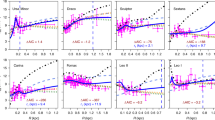Abstract
We argue that observations on Milky Way and dwarf spheroidals imply existence of individual haloes around dwarf spheroidals. If neutrinos (or any other ‘hot’ particle) provide the dark matter then we show that: (i) Embedding of visible matter inside large (∼ few Mpc) dark matter islands is observationally untenable. (ii) Dwarf spheroidals possess dark matter haloes of about 10 kpc radius around them, and have an (M/L) ratio of about 104. (iii) The haloes of spiral galaxies (e.g. Milky Way) extend to about 100 kpc in radius. If ‘cold’ dark matter makes up the haloes, then no significant constraints are obtained. We discuss briefly the effect of these constraints on larger scales.
Similar content being viewed by others
References
Aaronson, M. 1983,Astrophys. J.,266, L11.
Bekenstein, J., Milgrom, M. 1984,Astrophys. J.,286, 7.
Blumenthal, G. R., Faber, S. M., Primack, J. R., Rees, M. J. 1984,Nature,311, 517.
Bond, J. R., Efstathiou, G., Silk, J. 1980,Phys. Rev. Lett,45, 1980.
Bosma, A. 1978,PhD Thesis, Groningen Univ.
Chandrasekhar, S. 1942, inPrinciples of Stellar Dynamics, Dover, New York.
Cowsik, R., Ghosh, P. 1986,J. Astrophys. Astr.,7, (in press).
Cowsik, R., McClelland, J. 1972,Phys. Rev. Letts.,29, 669.
Dekel, A., Aarseth, S. J. 1984,Astrophys. J.,283, 1.
Doroshkevich, A. G., Khlopov, M. Yu., Sunyaev, R. A., Szalay, A. S., Zeldovich, Ya. B. 1981,N. Y. Acad. Sci.,375, 32.
Faber, S. M. 1984, inProc. 1st ESO-CERN Symp., Large-Scale Structure of the Universe, Cosmology and Fundamental Physics, Eds G. Sethi & L. Van Hove, ESO, Germany, p. 187.
Faber, S. M., Gallagher, J. S. 1979,A. Rev. Astr. Astrophys.,17, 135.
Faber, S. M., Lin, D. N. C. 1983,Astrophys. J.,266, L17.
Frenk, C. S., White, S. D. M. 1982,Mon. Not. R. astr. Soc,198, 173.
Frenk, C. S., White, S. D. M., Davies, M. 1983,Astrophys. J.,271, 417.
Gerhstein, S. S., Zeldovich, Ya. B. 1966,JETP Lett.,4, 174.
Gunn, J. E., Knapp, G. R., Tremaine, S. D. 1979,Astr. J.,84, 1181.
Hartwick, F. D. A., Sargent, W. L. W. 1978,Astrophys. J.,221, 512.
Hegyi, D. J. 1984, inFormation and Evolution of Galaxies and Large Structures in the Universe, Eds J. Audouze & J. Tran Thanh Van, D. Reidel, Dordrecht, p. 149.
Hut, P., White, S. D. M. 1984,Nature,310, 637.
Innanen, K. A., Harris, W. E., Webbink, R. F. 1983,Astr. J.,88, 338.
Kaiser, N. 1983,Astrophys. J.,273, L17.
Klinkhamer, F. R., Norman, C. A. 1981,Astrophys. J.,243, L1.
King, I. 1962,Astr. J.,67, 471.
Lin, D. N. C., Faber, S. M. 1983,Astrophys. J.,266, L21.
Lin, D. N. C., Lynden-Bell, D. 1982,Mon. Not. R. astr. Soc,198, 707.
Lubimov, V. A., Novikov, E. G., Nozik, V. E., Tatyakov, E. F., Kosik, V. S. 1980,Phys. Lett.,94B, 266.
Lynden-Bell, D. 1967,Mon. Not. R. astr. Soc,136, 101.
Lynden-Bell, D. 1983, inKinematics, Dynamics, and Structure of Milky Way, (Ed. W. C. H. Shutter, D. Reidel, Dordrecht), p. 349.
Marx, G., Szalay, A. S. 1972, inProc. Neutrino 72, Technoinform, Hungary, p. 123.
Mellot, A. 1983,Mon. Not. R. astr. Soc,202, 595.
Mellot, A., 1985,Astrophys. J.,289, 2.
Mihalas, D., Binney, J., (Eds) 1981,Galactic Astronomy, Freeman, San Francisco.
Milgrom, M. 1983,Astrophys. J.,270, 365, 371, 384.
Peebles, P. J. E. 1979, inProc. Physical Cosmology, Les H ouches, Session XXXII, North-Holland, New York, p. 213.
Peebles, P. J. E. 1982,Astrophys. J.,258, 415.
Primack, J. R., 1984, preprint SLAC-PUB-3387.
Primack, J. R., Blumenthal, G. R., 1984, inFormation and Evolution of Galaxies and Large Structures in the Universe, Eds J. Audouze & J. Tran. Thanh Van, D. Reidel, Dordrecht, p. 163.
Rood, H. J., 1981,Rep. Prog. Phys.,44, 1076.
Rubin, V. C. 1979,Commun. Astrophys.,8, 79.
Rubin, V. C., Ford, W. K. J., Thonnard, N., Berstein, D. 1982,Astrophys. J.,261, 349.
Rubin, V. C., Thonnard, N., Ford, W. K. J. 1982,Astr. J.,87, 477.
Sato, H. 1981,N. Y. Acad. Sci.,375, 43.
Sato, H., Takahara, P. 1980,Prog. Theo. Phys.,64, 2029.
Tremaine, S. D., Gunn, J. E. 1979,Phys. Rev. Lett.,42, 407.
Wasserman, I. 1981,Astrophys. J.,248, 1.
Author information
Authors and Affiliations
Rights and permissions
About this article
Cite this article
Padmanabhan, T., Vasanthi, M.M. Nature and distribution of dark matter: 1. Dwarf spheroidals and milky way. J Astrophys Astron 6, 261–277 (1985). https://doi.org/10.1007/BF02715011
Received:
Accepted:
Issue Date:
DOI: https://doi.org/10.1007/BF02715011




